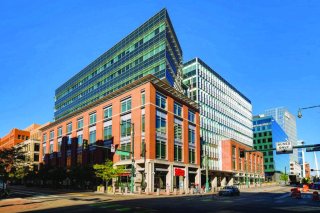Visiting EPA's Region 8 Office in Denver
- About EPA Region 8 facilities
- Visitor information
- Parking resources
- Introduction to the Region 8 states
About EPA Region 8 Facilities
The EPA Region 8 headquarters building is located at 1595 Wynkoop Street, along the 16th Street Mall in the Lower Downtown (LoDo) neighborhood of Denver. The building is located at the intersection of Wynkoop Street and 16th Street with its main entrance on 16th Street. The building is adjacent to Union Station and across from the Thirsty Lion Gastropub.
For those seeking places to dine, the 16th Street Mall, a pedestrian mall (closed to auto traffic) has many restaurants and a free bus running its 16-block length.
The Regional Laboratory is in Building 25 of the Denver Federal Center in Lakewood. The Montana Operations Office is in the Max Baucus Federal Building in Helena.
Mailing addresses are listed on the contacts page.
Visitor Information
Security Screening and REAL ID Requirements

The Region 8 building has airport-style security screening for visitors. Visitors are required to report to the second floor security area to sign in with uniformed security personnel. Visitors must be met by their sponsoring Region 8 employee. Visitors who need to go to space(s) above the second floor conference center must be escorted by a Region 8 employee at all times.
Visitors must present a REAL ID-compliant driver's license, an Enhanced Driver's License (EDL) or another acceptable form of identification to sign in.
Visitors must pass through a metal detector during the screening process. If the metal detector alarms, the individual will be required to undergo a secondary search with a handheld metal detector and may subsequently be subject to a pat down. Please review the following guidance to avoid delays and prevent the need for secondary screening:
- No weapons of any kind allowed (including pocket knives).
- No drugs or drug paraphernalia allowed (including marijuana).
- No large signs allowed at public hearings.
- Remove all items from all pockets and place in provided bins for screening.
- Remove laptops, phones or other electronic devices from their carrying case and place in provided bins for screening.
- Avoid shoes with metal shanks, toe guards, or supports as a part of their construction.
- Remove any outer cold weather layer(s) such as jackets, rain gear, vests, or sweaters etc., that may have metal as a part of their construction.
- Remove any metal belts, metal belt buckles, large jewelry, watches.
- Follow the instructions of the guard if identified for secondary screening.
Additionally:
- Taking photos or video is not allowed inside the building, except by recognized members of the media who have been pre-approved by EPA to take photos/video.
- If visitors will need WiFi access during their visit, the EPA sponsor must submit a Guest Wireless Network Account Request at least 24 hours before they arrive.
Other helpful links
Note: the information below links to Web sites outside the U.S. EPA Web site. These links are for your convenience. Such use does not constitute an official endorsement or approval by the U.S. EPA of any private sector Web site, product, or service. The U.S. EPA does not exercise any editorial control over the information you may find at these Web sites.
Parking Resources
There are numerous options for metered street parking and paid parking lots and garages around the building.
- Parking options in downtown Denver
- Downtown Denver maps This website features a wide variety of interactive maps and includes detailed information on hotels, restaurants and tourist attractions.
An Introduction to the Region 8 States
EPA's Region 8 office in Denver works to protect human health and the environment in Colorado, Montana, North Dakota, South Dakota, Utah, Wyoming and 28 sovereign Tribal nations. We share this challenging work with many partners – state, local and Tribal governments, businesses, non-governmental organizations, communities and individuals.
EPA Region 8 is unique. Our states encompass the heart of the American West, including much of the Rocky Mountains, Great Plains and Colorado Plateau. Over two-thirds of our roughly 13 million people live in two distinct bands of urban development – Colorado's Front Range and Utah's Wasatch Front. The Region is also home to some of the most rural counties in the nation. Characterized by vast open spaces– mountains, plains, canyons and deserts – and small, concentrated population centers, these areas still maintain some of the wild, frontier character that many associate with the West. They also contain many of our nation's most recognizable landscapes, including Yellowstone, Glacier, Rocky Mountain, Badlands, Zion, and dozens more national parks and monuments, millions of acres of forests, and even more range, farm and grassland.
Our Region is arid, placing a premium on the availability and quality of water resources to meet competing demands from farmers, municipalities, recreationists and ecological needs. Many rivers originate in the Rocky Mountain states including the Missouri, Rio Grande, Colorado, Arkansas and Platte Rivers; their waters are a vital source of life for people, plants and animals.
Land ownership patterns influence EPA's work in Region 8. Public lands - including those managed by the U.S. Forest Service, the Bureau of Land Management and the National Park Service – comprise over one-third of the land area in our Region. Tribal nations, which collectively cover an area greater than the size of Tennessee, are also prominent. EPA Region 8 works closely with our sister agencies and each of these 28 sovereign nations to protect human health and safeguard the natural environment.
Above all, our Region is defined by an abundance of natural resources, from fossil fuel deposits to vast expanses of wilderness rich in natural diversity. These resources support our states, Tribes and local communities and are a vital part of our regional and national identity. Region 8's economies – including agriculture, energy development, mining, recreation and tourism – thrive on these resources.
